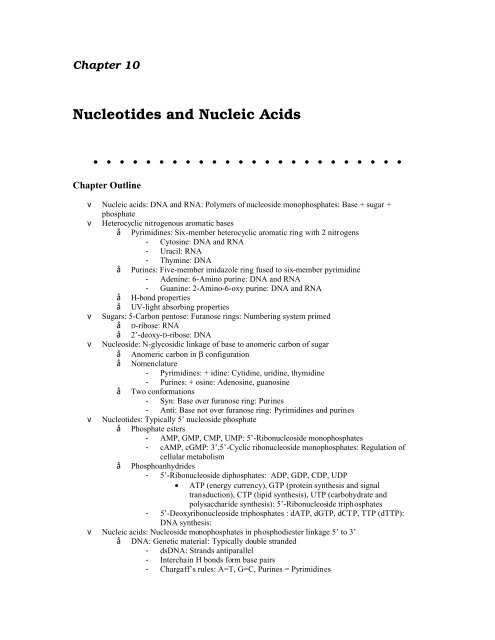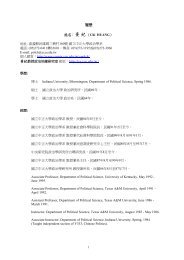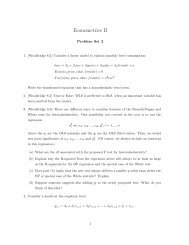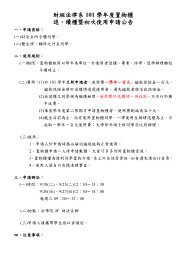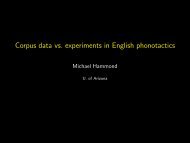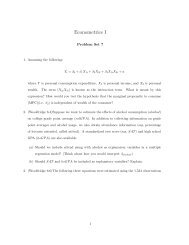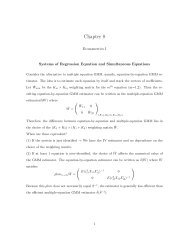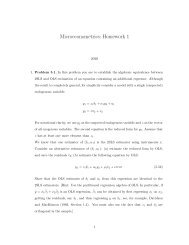Nucleotides and Nucleic Acids
Nucleotides and Nucleic Acids
Nucleotides and Nucleic Acids
- No tags were found...
Create successful ePaper yourself
Turn your PDF publications into a flip-book with our unique Google optimized e-Paper software.
Chapter 10<strong>Nucleotides</strong> <strong>and</strong> <strong>Nucleic</strong> <strong>Acids</strong>. . . . . . . . . . . . . . . . . . . . . . . .Chapter Outlinev <strong>Nucleic</strong> acids: DNA <strong>and</strong> RNA: Polymers of nucleoside monophosphates: Base + sugar +phosphatev Heterocyclic nitrogenous aromatic basesPyrimidines: Six-member heterocyclic aromatic ring with 2 nitrogens› Cytosine: DNA <strong>and</strong> RNA› Uracil: RNA› Thymine: DNAPurines: Five-member imidazole ring fused to six-member pyrimidine› Adenine: 6-Amino purine: DNA <strong>and</strong> RNA› Guanine: 2-Amino-6-oxy purine: DNA <strong>and</strong> RNAH-bond propertiesUV-light absorbing propertiesv Sugars: 5-Carbon pentose: Furanose rings: Numbering system primedD-ribose: RNA2’-deoxy-D-ribose: DNAv Nucleoside: N-glycosidic linkage of base to anomeric carbon of sugarAnomeric carbon in β configurationNomenclature› Pyrimidines: + idine: Cytidine, uridine, thymidine› Purines: + osine: Adenosine, guanosineTwo conformations› Syn: Base over furanose ring: Purines› Anti: Base not over furanose ring: Pyrimidines <strong>and</strong> purinesv <strong>Nucleotides</strong>: Typically 5’ nucleoside phosphatePhosphate esters› AMP, GMP, CMP, UMP: 5’-Ribonucleoside monophosphates› cAMP, cGMP: 3’,5’-Cyclic ribonucleoside monophosphates: Regulation ofcellular metabolismPhosphoanhydrides› 5’-Ribonucleoside diphosphates: ADP, GDP, CDP, UDP• ATP (energy currency), GTP (protein synthesis <strong>and</strong> signaltransduction), CTP (lipid synthesis), UTP (carbohydrate <strong>and</strong>polysaccharide synthesis): 5’-Ribonucleoside triphosphates› 5’-Deoxyribonucleoside triphosphates : dATP, dGTP, dCTP, TTP (dTTP):DNA synthesis:v <strong>Nucleic</strong> acids: Nucleoside monophosphates in phosphodiester linkage 5’ to 3’DNA: Genetic material: Typically double str<strong>and</strong>ed› dsDNA: Str<strong>and</strong>s antiparallel› Interchain H bonds form base pairs› Chargaff’s rules: A=T, G=C, Purines = Pyrimidines
Chapter 10 . <strong>Nucleotides</strong> <strong>and</strong> <strong>Nucleic</strong> <strong>Acids</strong>› X-ray diffraction of Franklin <strong>and</strong> Wilkins <strong>and</strong> model building of Watson <strong>and</strong>CrickRNA: Typically single str<strong>and</strong>ed: Produced during transcription› mRNA: Carries information encoded in genes to direct protein synthesis onribosomes• Derive from heterogeneous nuclear RNA (hnRNA)• RNA processed by splicing (removal of introns <strong>and</strong> joining of exons),capping (5’ end), <strong>and</strong> polyA tail addition (3’ end)› rRNA: Components of ribosome: Protein synthesis• Small subunit of ribosome: Single rRNA• Large subunit of ribosome: Large subunit rRNA, 5S rRNA, <strong>and</strong> ineukaryotes 5.8S rRNA› tRNA: Carriers of activated amino acids used by ribosome for protein synthesis› snRNA: Small nuclear RNAs› siRNAs: Small interfering RNAs: Degrade mRNAs› miRNAs: Bind to mRNA <strong>and</strong> block translation› snoRNAs: Required for certain RNA modificationsDNA vs RNA› Composition• T in DNA not U to distinguish from T formed by deamination of C• 2’ OH in RNA accounts for instability of RNA phosphodiester bond› Hydrolysis• RNA: Sensitive to base hydrolysis: Resistant to acid hydrolysis• DNA: Resistant to base hydrolysis: Depurinates by acid hydrolysis(apurinic base)v Nucleases: Enzymes that hydrolyze nucleic acidsExo-: Attack from endsEndo-: Attack internallya-Side cleavage: Attacks of 3’ side produces 5’ phosphorylated productb-Side cleavage: Attacks of 5’ side produces 3’ phosphorylated productRNases: RNA specificDNases: DNA specificNucleases: Cleave either DNA or RNARestriction endonucleases› Type I <strong>and</strong> Type III: Cleavage requires ATP› Type II: Cleavage site 4,6,8 base sequence with two-fold axis of symmetryChapter ObjectivesUnderst<strong>and</strong> the difference between a nucleoside <strong>and</strong> a nucleotide. The nucleotides arephosphorylated derivatives of nucleosides, compounds made up of a sugar <strong>and</strong> a nitrogenousbase. (See Figure 10.11.)143
Chapter 10 . <strong>Nucleotides</strong> <strong>and</strong> <strong>Nucleic</strong> <strong>Acids</strong>Figure 10.11 The common ribonucleosides - cytidine, uridine, adenosine, <strong>and</strong> guanosine. Also,inosine drawn in the anti conformation.It is important to know the structures of the pyrimidines <strong>and</strong> purines. Pyrimidines are sixmemberedheterocyclic, conjugated rings, whereas purines have a five-membered imidazole ringfused to a six-membered ring. (The small pyrimidine has a large name whereas the large purinehas a small name.) The commonly occurring pyrimidines have two nitrogens separated by acarbonyl group. In uracil <strong>and</strong> thymine, an additional carbonyl group is located adjacent to oneof the nitrogens <strong>and</strong> adjacent to it is a carbon with either a hydrogen (in uracil) or a methylgroup (in thymine). Cytosine has an amino group replacing one of the carbonyl oxygens of uracil(oxidative deamination of cytosine produces uracil). In the purine double ring, the carbonseparating the two nitrogens of the six-membered ring section has a hydrogen in adenine <strong>and</strong> anamino group in guanine. A carbonyl group is located adjacent to one of the nitrogens of the sixmemberedring in guanosine (2-amino-6-hydroxypurine), which is substituted for an aminogroup in adenine (6-aminopurine).You should be able to draw the structures of the bases <strong>and</strong> be able to identify hydrogen-bonddonor <strong>and</strong> acceptor groups. Also, know the groups involved in base pairing in double-str<strong>and</strong>edDNA.The compounds like ADP, ATP, GTP, UTP, CTP, NAD + FAD, Coenzyme A, etc., are all eithernucleotides or nucleotide derivatives of the ribonucleotides. The phosphate groups are usuallyattached to the 5' carbon of the ribose sugar. The dNTPs are used as precursors for DNA.The convention for writing a nucleic acid sequence is to write, from left to right, the one-letterabbreviations of the bases from the 5'-end to the 3'-end.The abbreviations most commonly found are A, C, G, T, U, N (any nucleotide, baseunspecified), R (purine), <strong>and</strong> Y (pyrimidine). 1Know what phosphodiester bonds are <strong>and</strong> that they join the 3'-hydroxyl group of a nucleotideto the 5' phosphate of an adjacent nucleotide in DNA <strong>and</strong> RNA. The single-str<strong>and</strong>ed polymersthus formed have a 5'-end <strong>and</strong> a 3'-end. DNA is predominantly double-str<strong>and</strong>ed, a fact reflectedin Chargaff's rules.The total DNA content of a haploid cell is its genome size. Diploid cells have two copies ofDNA while haploid cells have a single copy of DNA. The discrete molecules of cellular DNA arechromosomes. Cells may have a single chromosome or several chromosomes. Chromosomesare circular DNA molecules in some organisms <strong>and</strong> linear DNA molecules in others.RNA molecules are much less stable than DNA molecules. RNA is sensitive to base-catalyzedcleavage because of the presence of a hydroxyl group on the 2'-ribose carbon. Cells have an1 There is an extended code, less commonly used, that covers other combinations of bases. Bspecifies C, G, or T (i.e., anything but A). D indicates A, G, or T (i.e., not C). H is anything but G.V refers to A, C, or G. W signifies either A or T, the weak base-pair formers. S refers to G or C,the strong base-pair formers. A or C is denoted by M, for amino, <strong>and</strong> G or T is specified by K forketo.144
Chapter 10 . <strong>Nucleotides</strong> <strong>and</strong> <strong>Nucleic</strong> <strong>Acids</strong>abundance of RNases, which are often extremely stable, active enzymes. Finally, RNA is usuallyfound as a single-str<strong>and</strong>ed molecule whereas DNA is usually found in a double-str<strong>and</strong>ed form inwhich bases are protected by being sequestered in the interior of the structure.The type II restriction endonucleases are DNA-specific DNases that recognize palindromicsequences of DNA <strong>and</strong> cut within the sequence. Underst<strong>and</strong> what is meant by palindromic DNA<strong>and</strong> that after restriction endonuclease cleavage, the resulting ends may be blunt-ended, or haveeither 5'- or 3'- overhangs. It is a rather easy task to identify an uninterrupted palindrome byinspection. Scan the sequence of bases for adjacent, base-pair nucleotides (i.e., AT, TA, CG,GC). Once a pair is located, inspect the flanking two nucleotides; if they are also base-pairednucleotides, then they are part of a four-base palindrome. Six-base palindromes are commonrecognition sequences for a large number of restriction endonucleases.The relationship between DNA, RNA, <strong>and</strong> protein is described in the central dogma outlinedin Figure 10.1 shown on the next page.Figure 10.1 The fundamental process of information transfer in cells. Information encoded in the nucleotide sequence of DNAis transcribed through synthesis of an RNA molecule whose sequence is dictated by the DNA sequence. As the sequence ofthis RNA is read (as groups of three consecutive nucleotides) by the protein synthesis machinery, it is translated into thesequence of amino acids in a protein. This information transfer system is encapsulated in the dogma: DNA∏RNA∏protein.Problems <strong>and</strong> Solutions145
Chapter 10 . <strong>Nucleotides</strong> <strong>and</strong> <strong>Nucleic</strong> <strong>Acids</strong>1. From the pKa values for nucleotides presented in Table 10.1, draw the principalionic species for 5’-GMP occurring at pH 2.Answer:HON-7 pKa 2.4OHO P OO-OHHOHN+NHHOHNNHNH 2N-1 pKa 9.4pKa's 0.7, 6.12. Draw the chemical structure of pACG.Answer:NH 2ONN-OPOCH 2ONNO-HHHOHOHNH 2-OPOONNOCH 2OHHHOOHHO-OPOONNHCH 2ONNNH 2HHHOHHOH146
Chapter 10 . <strong>Nucleotides</strong> <strong>and</strong> <strong>Nucleic</strong> <strong>Acids</strong>3. Chargaff's results (Table 10.3) yielded a molar ratio of 1.29 for A to G in ox DNA,1.43 for T to C, 1.04 for A to T, <strong>and</strong> 1.00 for G to C. Given these values, what are themole fractions of A, C, G, <strong>and</strong> T in ox DNA?Answer: For ox DNA: A/G = 1.29; T/C = 1.43; A/T =1.04, G/C = 1.00; (A + G)/(T + C) = 1.1What are the mole fractions of A, C, G, T? Before starting we should recognize that the data areinconsistent. For example,TC × A T = A C <strong>and</strong>AG × G C = A C soDoes T C × A T = A G × G C ?TC × A =1.43 ×1.04 =1.487TAG × G =1.29 ×1.00 =1.290CClearly, there are problems with the data. It is likely that the original data were concentrationsof A, G, T <strong>and</strong> C <strong>and</strong> if we had these data it would be trivial to calculate the mole fractions ofeach. Using the data given, we could get several different answers depending on which of theratios we used. Here is one possible answer. Let,f A + f G + f C + f T = 1.0where the terms are the mole fraction of each nucleotide.f A + f G + f T + f C = 1.0But, f A = 1.04 f T <strong>and</strong> f G =1.0 f C thus,1.04 f T +1.0 f C + f T + f C = 1.0, or2.04 f T + 2.0 f C = 1.0By substituting f T =1.43 f C we find that2.04 ×1.43 f C +2f C =1.0, <strong>and</strong>f C = 0.20And since G C =1.0, f G = 0.20f A =1.29f G =1.29×0.20f A = 0.26And, finally sincef Tf C=1.43,f T = 1.43 × f C =1.43 × 0.02 = 0.29The final answer is :f A = 0.26, f C = 0.20, f G = 0.20, f T = 0.29These are consistent with some of the data but not all of it. Below are other solutions you mightcome up with that are consistent with some of the data but not all of it.A C G T0.30 0.23 0.23 0.330.29 0.20 0.20 0.280.29 0.20 0.20 0.28By treating the data as several equations in A, G, T <strong>and</strong> C one can come up with a solution thatbest fits all the data. Using A/G = 1.29, here is an example of one such equation:A – 1.29G + 0*C + 0*T = 0The others are (from T/C = 1.43, A/T = 1.04, A/G = 1, A+G/C+T = 1.1 <strong>and</strong> A + T + C + G = 1,):0*A + 0*G – 1.43C + T = 0A + 0*G + 0*C + 1.04T = 0A – G + 0*C + 0*T = 0A + G - 1.1C - 1.1T = 0147
Chapter 10 . <strong>Nucleotides</strong> <strong>and</strong> <strong>Nucleic</strong> <strong>Acids</strong>A + G + C + T = 1.0We have six equations. What we want to do is find the best solutions for A, G, C <strong>and</strong> T that,when substituted into these equations, make them as consistent as possible. To do this we needto rearrange them such that they all are functions that equal zero. The first five are already inthis form. The sixth would be A + G + C + T –1 = 0.We then square each, sum them <strong>and</strong> then find solutions for A, G, C <strong>and</strong> T that minimize thesum of the squares. (In effect, this is a form of a least squares solution.) (The solution can beobtained using matrix algebra.) The answer is A = .295, G = .223, C = .201 <strong>and</strong> T = .280.As an overkill, it must be that since the input data were A, G, T <strong>and</strong> C, some of the relationshipspresented in Table 10.3 are not truly independent. For example, the ratio of purines topyrimidines must have been calculated with A, G, C, <strong>and</strong> T as input. If we eliminate thisrelationship from the analysis the answer is A = .289, T = .286, G = .218 <strong>and</strong> C = .206.4. Results on the human genome published in Science (Science 291:1304-1350 [2001])indicate that the haploid human genome consists of 2.91 gigabase pairs (2.91 x 10 9base pairs) <strong>and</strong> that 27% of the bases in human DNA are A. Calculate the number of A,T, G, <strong>and</strong> C residues in a typical human cell.Answer: We are dealing with double-str<strong>and</strong>ed DNA so the number of bases is twice the numberof base pairs. However, we are asked for the number in a typical human cell. Since the vastmajority of human cells are diploid we will be dealing with a cell containing twice the DNAamount listed for the haploid cell. The percentage of A bases is given as 27%. It must be truethat there are an equal number of T’s. The number of G’s <strong>and</strong> C’s must be equal <strong>and</strong> they areequal to the total number of bases minus the number of A’s <strong>and</strong> T’s.A + T +G +C = 2 ×2×2.91×10 9And, A = TAnd, A = 0.27×2×2×2.91×10 9And, A = 3.14 ×10 9T = 3.14 ×10 9Substituting these values into the first equation <strong>and</strong> setting G = C,3.14 ×10 9 +3.14 ×10 9 +G +G = 2×2×2.91×10 9Solving for for G we get G = 2.68 ×10 9And since C = G, C = 2.68×10 95. Adhering to the convention of writing nucleotide sequences in the 5' 3' direction,what is the nucleotide sequence of the DNA str<strong>and</strong> that is complementary tod-ATCGCAACTGTCACTA?Answer:5'-TAGTGACAGTTGCGAT-3'Note: The complementary sequence written ‘5’ to 3’ is sometimes referred to as the reversecomplementary sequence. (As an example, consider the sequence GAGGCTT. Its reverse isTTCGGAG i.e., the sequence literally written in reverse. For the reverse sequence by exchangingeach base for its complementary base (i.e., A for T <strong>and</strong> G for C) we have AAGCCTC, which is thestr<strong>and</strong> that is complementary to GAGGCTT but written 5’ to 3’. When the reversecomplementary sequence is so defined the complementary sequence is defined literally. Thus,the complementary sequence of GAGGCTT is CTCCGAA.)6. Messenger RNAs are synthesized by RNA polymerases that read along a DNA templatestr<strong>and</strong> in the 3' 5' direction, polymerizing ribonucleotides in the 5' 3' direction (seeFigure 10.24). Give the nucleotide sequence (5' 3') of the DNA template str<strong>and</strong> fromwhich the following mRNA segment was transcribed:5'-UAGUGACAGUUGCGAU-3'.148
Chapter 10 . <strong>Nucleotides</strong> <strong>and</strong> <strong>Nucleic</strong> <strong>Acids</strong>9. Based on the information in Table 10.5, describe two different 20-base nucleotidesequences that have restriction sites for BamHI, PstI, SalI, <strong>and</strong> SmaI. Give the sequencesof the SmaI cleavage products of each.Answer: Table 10.5 lists type II restriction endonucleases, their recognition sequence, where inthe sequence the enzyme cuts in addition to other information. BamHI, PstI, SalI <strong>and</strong> SmaI allrecognize six-base restriction sites. Since we are asked to produce a 20-base sequence we aregoing to have to have restriction sites overlap. We are not asked to order the sites so this leaveus free to try several combinations.EnzymeBamHIPstISalISmaIRecognitionSequenceGGATCCCTGCAGGTCGACCCCGGGLooking at the recognition sequences it is clear that having BamHI <strong>and</strong> SmaI adjacent to eachother will allow a two-base overlap (of G’s or C’s, depending on order). So we could start outwith either of these two:1. GGATCCCGGG or 2. CCCGGGATCCTo 1. we could add PstI <strong>and</strong> SalI sites with single base overhangs as follows:CTGCAGGATCCCGGGTCGACDigestion of this oligonucleotide with SmaI would produce:CTGCAGGATCCC <strong>and</strong> GGGTCGACTo 2. we could add PstI <strong>and</strong> SalI sites with single base overhangs as follows:GTCGACCCGGGATCCTGCAGDigestion of this oligonucleotide with SmaI would produce:GTCGACCC <strong>and</strong> GGGATCCTGCAGAlternatively, we could have started with the BamHI/SmaI overlapped DNA on an end <strong>and</strong> thenadded in the other sites.For 1. we would get:GGATCCCGGGTCGACTGCAGDigestion of this oligonucleotide with SmaI would produce:GGATCCC <strong>and</strong> GGGTCGACTGCAGFor 2. we would get:CTGCAGTCGACCCGGGATCCDigestion of this oligonucleotide with SmaI would produce:CTGCAGTCGACCC <strong>and</strong> GGGATCC10. The synthesis of RNA can be summarized by the reaction:n NTP (NMP)n + n PPiWhat is the •Gº’overall for synthesis of an RNA molecule 100 nucleotides in length,assuming the •Gº’ for transfer of an NMP from an NTP to the 3’-O of polynucleotidechain is the same as the •Gº’ for transfer of an NMP from an NTP to H20? (Use datagiven in Table 3.3.)Answer: From Table 3.3 we are informed that the •Gº’ for hydrolysis of ATP to AMP <strong>and</strong> PPi is –32.3 kJ/mol. This reaction is in effect a transfer of AMP from ATP to water. We are allowed toassume that transfer of AMP from ATP to the 3’ end of a polynucleotide chain has •Gº’ of +32.3kJ/mol. To make a polymer 100 nucleotides long let us start with hydrolysis of a single NTP toNMP <strong>and</strong> PP with a very favorable •Gº’ of –32.3 kJ/mol. The NMP would then be used in atransfer reaction with NTP to make the first phosphodiester bond with an unfavorable •Gº’ of151
Chapter 10 . <strong>Nucleotides</strong> <strong>and</strong> <strong>Nucleic</strong> <strong>Acids</strong>+32.3 kJ/mol. To make 99 phosphodiester bonds, the number in a 100-base-longpolynucleotide, the reaction would have to be repeated 98 times. Thus,•Gº’overall = -32.3 +99 x 32.3 kJ/mol = 3,165.4 kJ/molIf we were to have simply made 99 phosphodiester bonds it would require:•Gº’overall = 99 x 32.3 kJ/mol = 3,198 kJ/molHowever, the RNA would have a triphosphate at its 5’ end.11. Gene expression is controlled through the interaction of proteins with specificnucleotide sequences in double-str<strong>and</strong>ed DNA.a. List the kinds of noncovalent interactions that might take place between a protein<strong>and</strong> DNA.b. How do you suppose a particular protein might specifically interact with a particularnucleotide sequence in DNA? That is, how might proteins recognize specific basesequences within the double helix?Answer: a. The weak forces are hydrophobic interaction, van der Waals interactions, hydrogenbonds <strong>and</strong> ionic bonds. Of these we might not expect excessive hydrophobic interactions tooccur between a protein <strong>and</strong> dsDNA because dsDNA presents virtually little in the way ofhydrophobic surfaces to the solvent. The bases themselves are hydrophobic but they arestacked in dsDNA. One might expect hydrogen bonding to occur between a protein <strong>and</strong> bases ina DNA sequence. One might also expect ionic bonding between the negatively-chargedsugar/phosphate backbone of DNA <strong>and</strong> positively-charged amino acid residues from arginine<strong>and</strong> lysine.b. Without unwinding dsDNA a protein would have to make base-specific interactions via eitherthe major groove or minor groove. There is more information regarding the identity of base pairsin the major groove. In addition, the dimensions of an α-helix are compatible with the space inthe major groove. Thus, one might expect proteins to bind via the major groove.12. Restriction endonucleases also recognize specific base sequences <strong>and</strong> then act tocleave the double-str<strong>and</strong>ed DNA at a defined site. Speculate on the mechanism by whichthis sequence recognition <strong>and</strong> cleavage reaction might occur by listing a set ofrequirements for the process to take place.Answer: Restriction enzymes bind double-str<strong>and</strong>ed DNA at sites that have two-fold rotationalsymmetry <strong>and</strong> they cleave both str<strong>and</strong>s at identical places on the DNA. For this event to occurefficiently, both str<strong>and</strong>s have to be recognized <strong>and</strong> cleaved at the same time. An efficient way ofdoing this is to have the enzyme function as a homodimer binding to the major groove.One could envision a restriction endonuclease functioning as a monomer, binding to dsDNA viathe major groove <strong>and</strong> hydrolyzing a single str<strong>and</strong>. To simultaneously cleave the second str<strong>and</strong>would require a second catalytic site on the enzyme. Alternatively, the enzyme might, uponcleavage of one str<strong>and</strong>, release from the DNA <strong>and</strong> rebind to it to cleave the second str<strong>and</strong>. Nicksin dsDNA can unwind, making it difficult to be recognized by an enzyme that initially bound todsDNA. One could imagine a DNA binding site that recognizes single-str<strong>and</strong>ed DNA sequences.This, however, would complicate binding to dsDNA. So, one could envision a protein with twocatalytic sites or two DNA binding sites, one ssDNA specific <strong>and</strong> one dsDNA specific.Dimerization, however, seems like a simple way to avoid these complications.13. A carbohydrate is an integral part of a nucleoside.a. What advantage does the carbohydrate provide?Polynucleotides are formed through formation of a sugar-phosphate backbone.b. Why might ribose be preferable for this backbone instead of glucose?c. Why might 2-deoxyribose be preferable to ribose in some situations?Answer: a. A nucleoside is a base in glycosidic linkage to a sugar. Bases are poorly watersoluble<strong>and</strong> attachment to a sugar will improve their water solubility. Sugars present numeroushydroxyl groups that contribute to water solubility <strong>and</strong> provide attachment points for othermolecules.152
Chapter 10 . <strong>Nucleotides</strong> <strong>and</strong> <strong>Nucleic</strong> <strong>Acids</strong>b. c. Moving from hexose to ribose to deoxyribose there is a decrease in the number of hydroxylgroups. DNA is much more stable to alkaline hydrolysis than RNA because it lacks a 2’hydroxyl, which in RNA can attack nearby phosphodiester linkages. One could imagine hexosesbeing even worse in this regard. The use of a hexose in place of a ribose might make packagingof DNA more difficult. The presence of additional hydroxyl groups would require more exposureto water molecules. Further, there would be an increases likelihood that unwanted sidereactions involving hydroxyl groups occur.14. Phosphate groups are also integral parts of nucleotides, with the second <strong>and</strong> thirdphosphates of a nucleotide linked through phosphoric anhydride bonds, an importantdistinction in terms of the metabolic role of nucleotides.a. What property does a phosphate group have that a nucleoside lacks?b. How are phosphoric anhydride bonds useful in metabolism?c. How are phosphate anhydride bonds an advantage to energetics of polynucleotidesynthesis?Answer: a. The addition of phosphates will further increase the water solubility of nucleosidesby adding negative charge.b. c. Phosphoanhydride bonds are strongly exergonic <strong>and</strong> their hydrolysis can be used to drivereactions including polynucleotide synthesis.15. The bases of nucleotides <strong>and</strong> polynucleotides are “information symbols.” Theircentral role in providing information content to DNA <strong>and</strong> RNA is clear. Whatadvantages might bases as “information symbols” bring to the roles of nucleotides inmetabolism?Answer: In metabolism, nucleotides are used both to energize compounds <strong>and</strong> to tag them forspecific metabolic fates. For example, glucose destined for storage in glycogen is converted toUDP-glucose. In lipid metabolism, CTP plays a role in activation of phospholipids. Finally, GTPis used in protein synthesis <strong>and</strong> signal transduction pathways.16. Structural complementarity is the key to molecular recognition, a lesson learned inChapter 1. The principle of structural complementarity is relevant to answeringproblems 5, 6, 7, 11, 12, <strong>and</strong> 15. The quintessential example of structuralcomplementarity in all of biology is the DNA double helix. What features of the DNAdouble helix exemplify structural complementarity?Answer: Structural complementarity of double-str<strong>and</strong>ed DNA is due to complementary basepairs. The fact that bases pair allows for efficient replication <strong>and</strong> repair of DNA. Even in thecase of double-str<strong>and</strong>ed breaks, repair mechanisms based on homologous recombination canrejoin DNA molecules.Questions for Self Study1. Fill in the blanks. The two basic kinds of nucleic acids are <strong>and</strong> . They are composedof building blocks termed ; however, the building blocks are not identical for the two kinds ofnucleic acids. One contains the five carbon sugar whereas the other has a modified form ofthis sugar or . The building blocks all contain nitrogenous bases attached to the sugar bybonds. The nitrogenous bases are either derivatives of the 6-membered heterocyclic ringcompound or of purines, a compound composed of a 6-membered heterocyclic ring with a 5-membered ring fused to it. The two common purines are <strong>and</strong>. The 6-membered heterocyclic ring compounds include , , <strong>and</strong> . A ring compoundattached to a sugar is termed a .2. Answer True or Falsea. ATP is an example of a deoxynucleoside triphosphate .b. cAMP is a 3'-5' cyclic form of AMP .c. The α phosphate of GTP is the phosphate closest to the sugar moiety .d. The only biological function of dCTP is as a building block in synthesis of153
Chapter 10 . <strong>Nucleotides</strong> <strong>and</strong> <strong>Nucleic</strong> <strong>Acids</strong>DNA .e. The only biological function of CTP is as a building block in synthesis ofRNA .f. The most common ribonucleoside triphosphates have phosphate attached to the5' carbon of the sugar moiety .3. Chargaff's rules provided an important clue to solve the structure of double-str<strong>and</strong>ed DNA.What are Chargaff's rules?4. Answer True of Falsea. An A/T base pair <strong>and</strong> a C/G base pair have about the same physicaldimensions .b. If GGGGCCCC represents the sequence of bases in one str<strong>and</strong> of a double-str<strong>and</strong>ed DNAthen the complementary str<strong>and</strong> must have the sequence CCCCGGGG .c. mRNA is single-str<strong>and</strong>ed .d. Heterogeneous nuclear RNA or hnRNA are RNA molecules made in the nucleus <strong>and</strong>processed into mRNA .e. rRNA <strong>and</strong> tRNA are devoid of unmodified nucleosides .5. DNA <strong>and</strong> RNA react differently to acid <strong>and</strong> base conditions. Explain.6. Of the following statements, which are true for type II restriction enzymes?a. They are usually exonucleases.b. Their recognition sequences are palindromic.c. Cleavage is by hydrolysis of both str<strong>and</strong>s.d. Cleavage produces 3'-phosphates <strong>and</strong> 5' hydroxyl groups.e. A single restriction enzyme can produce blunt ends or protruding ends depending on thesalt conditions.Answers1. DNA; RNA; nucleotides (or nucleoside monophosphates); ribose; deoxyribose; glycosidic;pyrimidine; imidazole; adenine; guanine; cytosine; uracil; thymine; nucleoside.2. a.F; b.T; c.T; d.T; e.F; f.T.3. [A]= [T]; [G] = [C]; [pyrimidines] = [purines]4. a.T; b.F (sequences are always written 5' to 3'); c.T; d.T; e.F.5. RNA is relatively resistant to dilute acid whereas DNA undergoes hydrolysis of glycosidicbonds to purines. DNA is not susceptible to alkaline hydrolysis whereas RNA is readilyhydrolyzed to nucleotides in alkaline solution.6. b <strong>and</strong> c.Additional Problems1. The nucleotides are an important class of biomolecules used as components of the nucleicacids, DNA <strong>and</strong> RNA. Describe the structure of the nucleoside monophosphates found in DNA<strong>and</strong> RNA. In your description be sure to describe the three chemical groups that make up anucleotide <strong>and</strong> be certain to indicate any difference between deoxyribonucleotides <strong>and</strong>ribonucleotides.2. Draw a base pair involving either G <strong>and</strong> C or A <strong>and</strong> T.3. DNA methylation is known to most commonly occur at position 6 in A <strong>and</strong> position 5 in C.However, the formation of 5-methylcytosine can create so-called mutational hot-spots. Cytosinecan undergo oxidative deamination at position 4. In the unmethylated form, this deamination154
Chapter 10 . <strong>Nucleotides</strong> <strong>and</strong> <strong>Nucleic</strong> <strong>Acids</strong>can be corrected, because it is easily recognized. Deamination of 5-methylcytosine, however,can create problems. Explain.4 In the following sequence of DNA, underline a 4-base palindrome, a 6-base palindrome <strong>and</strong> apurine-rich sequence.GAGAAATATAGATCAGAGTTAACTC5. In the following compounds, the order of solubility is adenine < deoxyadenosine < adenosine< adenosine triphosphate. Explain what each is (i.e., base, nucleoside or nucleotide), how theydiffer <strong>and</strong> why they show this relative solubility.6. When a solution of double-str<strong>and</strong>ed DNA is heated, a sharp transition is observed in theultraviolet absorption properties of the solution. The solution begins to absorb greater amountsof light at high temperatures, corresponding to the process of denaturation. What physicalchanges in the double-str<strong>and</strong>ed DNA molecules occur during this process of denaturation?7. The restriction endonuclease BamHI recognizes the sequence GGATCC <strong>and</strong> cleaves betweenthe Gs. The enzyme Bgl II ("Bagel two") recognizes AGATCT <strong>and</strong> cuts between AG. What kind ofoverhangs are generated (i.e., 5' or 3')? Are the overhangs complementary to one another? If thecleavage products are joined together (i.e., a BamHI fragment joined to a Bgl II fragment), is thehybrid molecule cleavable by either endonuclease?Abbreviated Answers1. The nucleoside monophosphates found in DNA <strong>and</strong> RNA are composed of a phosphate group,a sugar moiety, <strong>and</strong> a nitrogenous base. The sugar is a 5-carbon compound, deoxyribose forDNA <strong>and</strong> ribose for RNA. The phosphate group is attached to the 5'-carbon of the sugar.Attached to the 1'-carbon is a nitrogenous base. Bases are either purines, adenine or guanine,or pyrimidines, cytosine in DNA <strong>and</strong> RNA, or thymine in DNA only or uracil in RNA only.(Thymine is 5-methyluracil.)2.155
Chapter 10 . <strong>Nucleotides</strong> <strong>and</strong> <strong>Nucleic</strong> <strong>Acids</strong>H-CNNCCAHCNNHHOCNTCCH 3CCNHSugarNCHOSugarHSugarH-CNNCCNGOCNCNHHHNCN CCOHCC HNSugarH3. Oxidative deamination of cytosine produces uracil, a base not commonly found in DNA. Cellshave a repair system that scans DNA for uracils <strong>and</strong> removes them. The presence of 5-methylcytosine causes problems for this repair process. Oxidative deamination of 5-methylcytosine produces 5-methyluracil also known as thymine. Thymine is a naturalcomponent of DNA.4.4-basepalindromesGAGAAATATAGATCAGAGTTAACTCpurine rich6-basepalindrome5. Adenine is a base. In general, the bases are poorly soluble in aqueous solution.Deoxyadenosine is a nucleoside composed of adenine <strong>and</strong> the 5-carbon sugar deoxyribose.Adenosine is a ribonucleoside containing the 5-carbon ribose sugar. Both deoxyadenosine <strong>and</strong>adenosine are more soluble than adenine by virtue of the hydroxyl groups on their sugarmoieties. Adenosine triphosphate is ATP, a ribonucleoside triphosphate. The presence of thetriphosphate group greatly increases solubility.6. The forces holding double-str<strong>and</strong>ed DNA together include hydrogen bonds <strong>and</strong> basestacking. Denaturation of double-str<strong>and</strong>ed DNA results in str<strong>and</strong>-separation <strong>and</strong> unstacking ofbases. Base stacking occurs by an interaction of π-electrons located above <strong>and</strong> below the baseplanes.One of the consequences of base-stacking is a decrease in the molar extinction156
Chapter 10 . <strong>Nucleotides</strong> <strong>and</strong> <strong>Nucleic</strong> <strong>Acids</strong>coefficient. Stacked bases have a lower extinction coefficient than unstacked bases. Thus,denaturation is accompanied by an increase in ultraviolet light absorption, a phenomenonknown as the hyperchromic effect. The ultraviolet absorbance of denatured DNA isapproximately 40% higher than that of native DNA.7. BamHI produces 5'-overhangs as shown below:5' 3' 5' 5' 3'GGATCC G GATCC+CCTAGG CCTAG G3' 5' 3' 5' 3'Bgl II also produces 5'-overhangs as shown below:5' 3' 5' 5' 3'AGATCT A GTACT+TCTAGA TCTAG C3' 5' 3' 5' 3'The overhangs are compatible but the hybrid site formed by joining a BamHI half site with aBglII half site is not recognized by either. The junction is no longer a 6-base palindrome.5' 5' 3' 5' 3'G GATCT GGATCT+CCTAG A CCTAGA3' 5' 5' 5' 3'BamHI BglII hybridhalf-site half-site siteSummaryThe nucleic acids, ribonucleic acid (RNA) <strong>and</strong> deoxyribonucleic acid (DNA), are importantbiopolymers of nucleotides, compounds containing nitrogenous bases, a five-carbon sugar(ribose or deoxyribose) <strong>and</strong> phosphate. This chapter describes the basic biochemistry of nucleicacids <strong>and</strong> nucleotides. The nitrogenous bases come in two types, pyrimidines <strong>and</strong> purines.Pyrimidines are 6-membered, heterocyclic, aromatic ring structures containing two nitrogens.There are three principal pyrimidines: cytosine, uracil <strong>and</strong> 5-methyluracil or thymine. Cytosineis found in both DNA <strong>and</strong> RNA whereas uracil is in RNA <strong>and</strong> thymine in DNA. The generalstructure of a purine is a 5-membered imidazole ring fused to a pyrimidine ring. In DNA <strong>and</strong>RNA, there are two common purines, namely adenine <strong>and</strong> guanine. Both purines <strong>and</strong>pyrimidines contain numerous groups that can participate in hydrogen bonds as donors oracceptors or both. In fact, complementary groups exist on adenine <strong>and</strong> uracil (or thymine) <strong>and</strong>on guanine <strong>and</strong> cytosine such that they can form hydrogen-bonded pairs. This base-pairing isthe foundation for the structure of double-str<strong>and</strong>ed DNA.Because the bases have extensive, conjugated double bonds, they absorb light strongly in theUV range. The conjugated bond system allows delocalization of π-electrons, forming electronclouds above <strong>and</strong> below the base plane. Delocalized π-electrons can interact by base stacking,another force stabilizing double-str<strong>and</strong>ed DNA. Base stacking also affects the efficiency ofelectronic transitions of π-electrons, such that stacked bases absorb less UV light thanunstacked bases. The transition from an ordered nucleic acid structure stabilized by hydrogenbonds <strong>and</strong> base stacking to an unordered structure is accompanied by an increase in UVabsorbance. This transition is known as denaturation <strong>and</strong> it results in a hyperchromic shift inUV absorption.Purines <strong>and</strong> pyrimidines have low water solubility which improves when they are attached toeither ribose or deoxyribose sugars through N-glycosidic bonds. The resulting compounds are157
Chapter 10 . <strong>Nucleotides</strong> <strong>and</strong> <strong>Nucleic</strong> <strong>Acids</strong>molecules. In particular, a class of RNA molecules known as small nuclear RNAs or snRNAs areresponsible for mRNA processing in the nucleus of eukaryotic cells.Apart from the number of str<strong>and</strong>s, there are only minor differences between DNA <strong>and</strong> RNA:deoxyribose versus ribose sugars, <strong>and</strong>, thymine versus uracil. The absence of a 2'-OH group indeoxyribose makes DNA stable against base-catalyzed hydrolysis. In fact, DNA is a very stablemolecule ideally suited as genetic material. The choice between thymine <strong>and</strong> uracil arises as aresult of the tendency of cytosine to deaminate to uracil. Since thymine is found in DNA, anyuracil in DNA must result from deamination of cytosine. Cells have enzymes to remove uracil inDNA, replacing it with thymine <strong>and</strong> thus preventing mutations.There is a large number of enzymes, termed nucleases, that catalyze cleavage ofphosphodiesterase bonds by hydrolysis. These include DNA-specific enzymes (DNases), RNAspecificenzymes (RNases) or nonspecific nucleases that attack either internal phosphodiesterbonds (endonucleases) or phosphodiester bonds on the end of a polymer (5'-exonucleases or 3'-exonucleases). Further, the phosphodiester bond may be attacked on the a side producing a 5'-phosphate or on the b side producing a 3'-phosphate. Restriction endonucleases are DNAspecificendonucleases. There are three types (I, II, <strong>and</strong> III) of restriction endonucleases. Type Icleaves DNA without regard to sequence; type II recognizes specific sequences, oftenpalindromic, <strong>and</strong> cleaves within the sequence; type III recognizes a specific DNA sequence <strong>and</strong>cleaves nearby. Type II restriction endonucleases are important tools in genetic engineering <strong>and</strong>molecular biology.159


